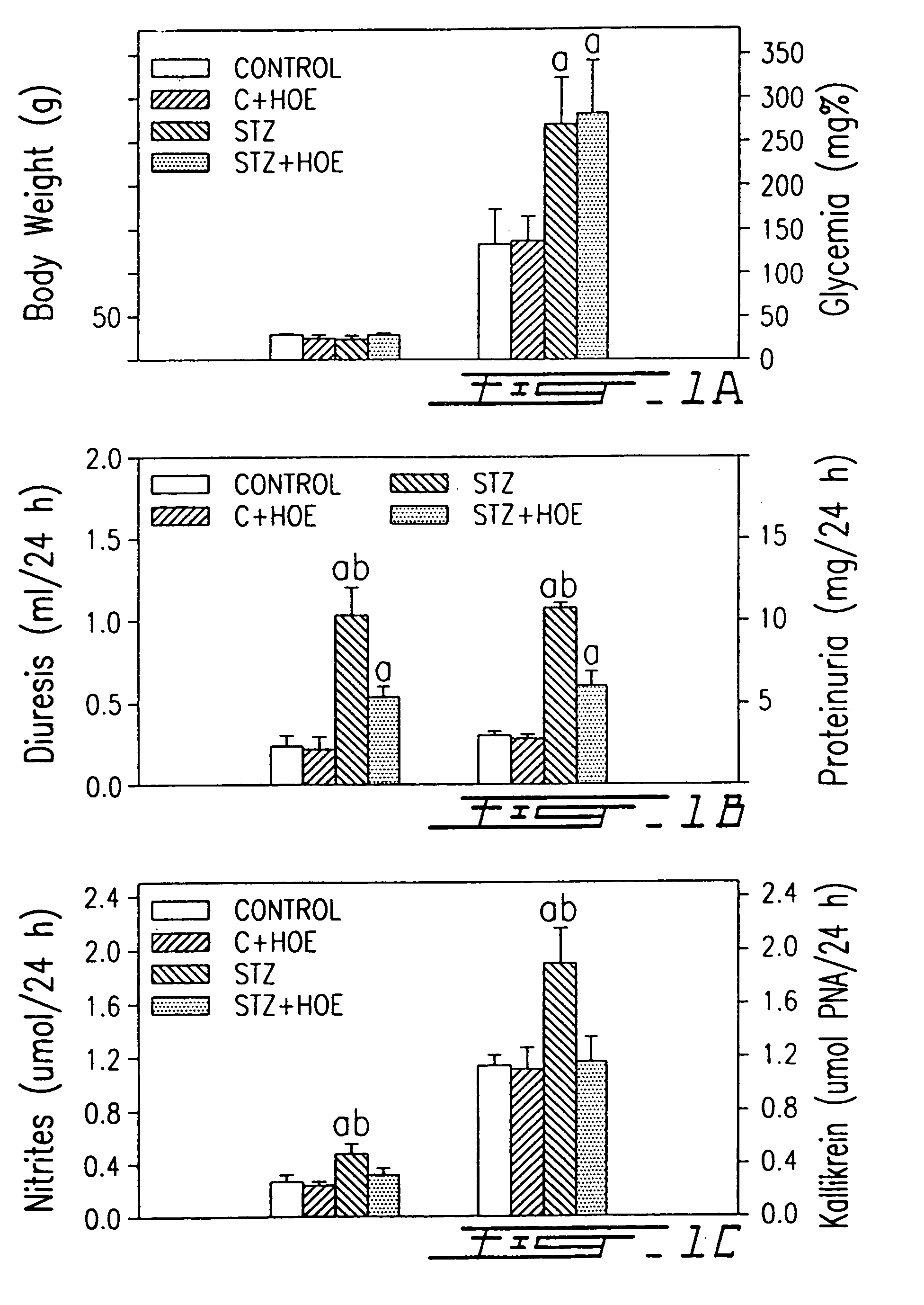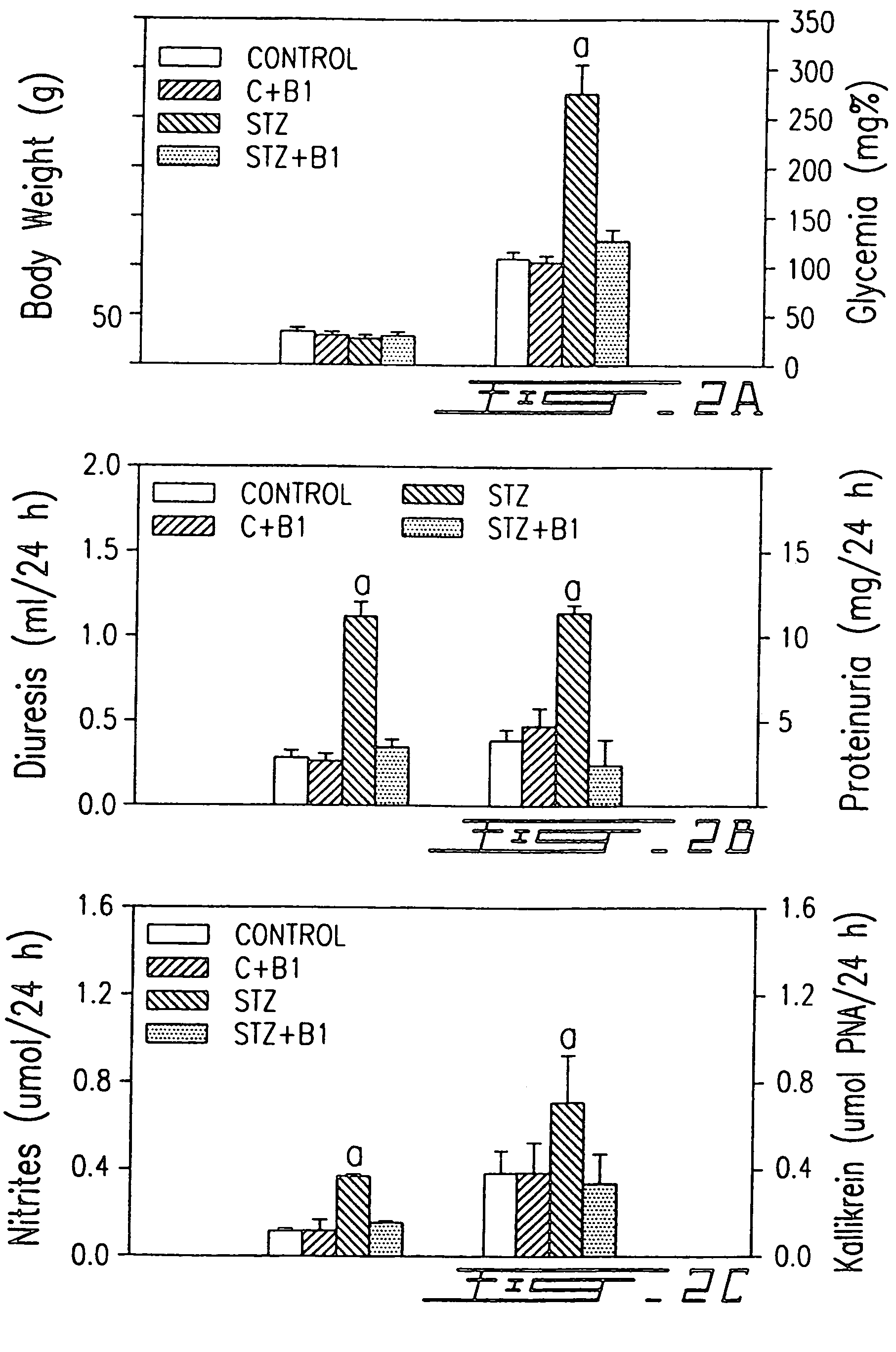B1-bradykinin receptor antagonists and use thereof
a technology of bsub>1/sub>-bradykinin and receptor, which is applied in the field of b1antagonists, can solve the problems that none of them is selective for bsub>1/sub>-receptor when tested in model tissues, and achieves marked proteinuria, increased blood glucose, and increased diuresis
- Summary
- Abstract
- Description
- Claims
- Application Information
AI Technical Summary
Benefits of technology
Problems solved by technology
Method used
Image
Examples
example 1
Design and Activity of desArg9BK Analogs
Peptide Synthesis
[0023]All peptides were synthesized with an Applied Biosystems 430 A peptide synthesizer using Merrifield type resins with the first amino acid attached. Amino acids were activated by dicyclohexylcarbodiimide 1-hydroxybenzotriazole (Peptides International, Louisville, Ky.) on 1-methyl-2-pyrrolidinone. Peptides were cleaved from the resins with anhydrous HF in the presence of appropriate scavengers. The resulting peptides were purified by medium pressure reversed-phase (C18) chromatography and if necessary by HPLC. Peptide purity was assessed by analytical HPLC and identity confirmed by Ion spray mass spectrometry (VG Quattro, Manchester, U.K.).
Bioassays
[0024]Tissues were taken from New Zealand white rabbits (1.5–2.5 kg) and Dunken Hartley guinea pigs (250–350 g) of either sex, killed by stunning and exsanguination. Umbilical cords were taken from healthy women 22–40 years old after spontaneous delivery at term. The rabbit jugu...
example 2
B1-Bradykinin Receptor Blockade may Prevent Diabetes-Associated Vaculopathy
[0042]Capillary permeability is known to be selectively augmented in the streptozotocin (STZ) diabetic rat model49. The vascular BK receptors in the STZ-induced diabetic rat was examined. Segments of the portal vein (a known preparation for BK studies) from these rats were mounted in organ baths for isometric contraction studies. The response to desArg9BK, a specific BK–B1 receptor agonist, was enhanced by 118% in the diabetic tissue, compared to normal portal veins (0.48 vs 0.22g: P8)desArg9BK, a specific antagonist of the BK–B1 receptor. HOE140, the BK–B2 receptor antagonist, had no effect on the diabetic portal vein abnormality. Evans blue (EB: 20 mg / kg), a marker of albumin extravasation, was injected to unanesthetized diabetic rats. In two selected tissues where EB leakage was enhanced in diabetes (the skin and the pancreas (from 11 to 48, and from 44 to 92 ug / g dry tissue)), the BK–B1 receptor antagonis...
example 3
Hyperglycemia, Diuresis, Proteinuria, Nitrite and Kallikrein Urinary Excretion are all Normalized by B1-BK Receptor Blockade:
[0043]Streptozotocin has been extensively used to produce type I diabetes in animals. This experimental disease is characterized by a mild inflammatory reaction in the Langerhans islets. Because kinins have been proposed as prominent inflammatory mediators in the pathogenesis of several diseases, we evaluated the role of kinins and their receptors in the evolution of insulitis. Male C57BL / Ks mdb mice were injected with streptozotocin (40 mg / kg) for 5 consecutive days. The kinin B1 receptor antagonist (Leu8)desArg9BK or the B2 antagonist HOE140 were injected subcutaneously to STZ mice at 300 ug / Kg bw twice a day and 500 ug / Kg per day, respectively. Treatment with antagonists was started 3 days after STZ and lasted for 10 days. Plasma glucose was determined by the glucose oxidase method, and 13 days urinary samples were assayed for proteins, nitrites and kallikr...
PUM
| Property | Measurement | Unit |
|---|---|---|
| concentration | aaaaa | aaaaa |
| pH | aaaaa | aaaaa |
| concentration | aaaaa | aaaaa |
Abstract
Description
Claims
Application Information
 Login to View More
Login to View More - R&D
- Intellectual Property
- Life Sciences
- Materials
- Tech Scout
- Unparalleled Data Quality
- Higher Quality Content
- 60% Fewer Hallucinations
Browse by: Latest US Patents, China's latest patents, Technical Efficacy Thesaurus, Application Domain, Technology Topic, Popular Technical Reports.
© 2025 PatSnap. All rights reserved.Legal|Privacy policy|Modern Slavery Act Transparency Statement|Sitemap|About US| Contact US: help@patsnap.com



